Asset protection
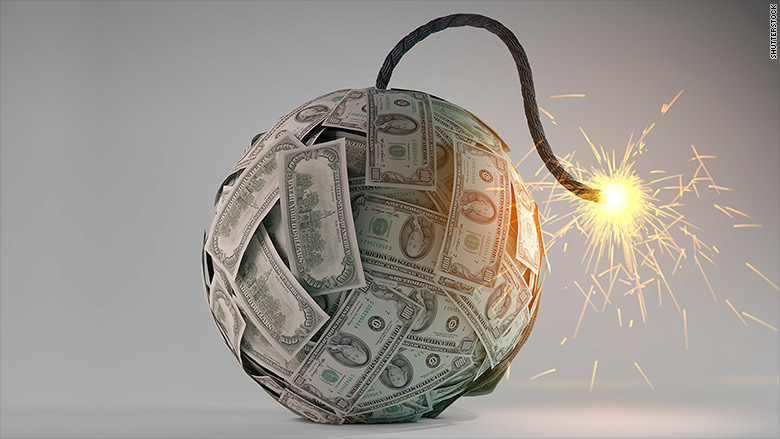 Nouriel Roubini, who called the 2008 financiial crisis, outlines the 4 things that investors should be worried about. He says a paradox has emerged in the financial markets since the 2008 global financial crisis. A series of recent shocks suggests that macro liquidity has become linked with severe market illiquidity.
Nouriel Roubini, who called the 2008 financiial crisis, outlines the 4 things that investors should be worried about. He says a paradox has emerged in the financial markets since the 2008 global financial crisis. A series of recent shocks suggests that macro liquidity has become linked with severe market illiquidity.
High-frequency traders and illiquid Bond exchanges compared to Stocks are just two reasons for investor concern. Read the other two reaaons in his full editorial HERE or an analysis of his editorial HERE – Money Talks Ed.

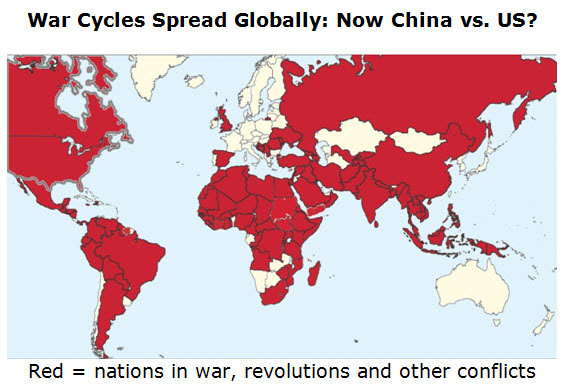
When I first forecast a rise in geopolitical turmoil in January 2013, few people believed me.
Many thought I was crazy or I was simply fearmongering.
Yet, here we are, only two and a half years into my warnings of a rising cycle of social and international unrest that will not peak until 2020 to 2022 …
And already, nearly everywhere you turn, geopolitical unrest is exploding off the charts.
Just consider the above map of the world from Uppsala University, the leading think tank on conflict, that highlights in red the countries at war, racked by revolutions or suffering other kinds of violent conflicts.
And consider …
– Israel and Gaza, still fighting a war that could easily spread throughout the entire Middle East.
– Vladimir Putin, bullying his way through Ukraine and likely to target other former Soviet Union satellite countries.
– Syria’s civil war, where more than 210,000 are now dead.
– Boko Haram, murdering and kidnapping hundreds of innocent people, crusading to create another Islamic state on the world’s second largest continent.-
– Nearly all of Africa, where there are now fully 24 countries engaged in wars, involving 146 different militias-guerrillas, separatist and anarchic groups.
– Asia, where 15 countries, involving 129 different radical and separatist groups, are waging wars and uprisings.
– Europe, where nine countries are under siege by 70 different militias, representing mostly separatist and anarchist groups.
– The Middle East, where eight countries and 169 different rebel groups are now engaged in conflict.
– The Americas, where five countries are either at war or experiencing massive domestic unrest, involving 25 different rebel and separatist groups and drug cartels.
– And the most violent of all, ISIS, the Islamic State, known for its harsh Wahhabist interpretation of Islam and brutal violence directed at Shia Muslims and Christians in particular. Terrorizing the Middle East, killing tens of thousands.
And these are just the “officially” recognized conflicts.
They do not include other hot spots around the world that are likely to lead to either civil or international war, including yes, the potential for armed conflict between China and the U.S.
I was perhaps one of the first to warn of this potential conflict, way back in 2004. In an issue of my Real Wealth Report, I explicitly described how China would move into the South China Sea, specifically targeting the Spratly Islands, the region’s oil and gas reserves and shipping routes.
That’s where China can grab an undeveloped, but easily exploited, 100 billion barrels of oil and 882 billion cubic feet of natural gas.
And that’s where the volume of oil — shipped through the South China Sea — is three times greater than the volume shipped through the Suez Canal (pipeline included) and fifteen times greater than the oil that flows through the Panama Canal.
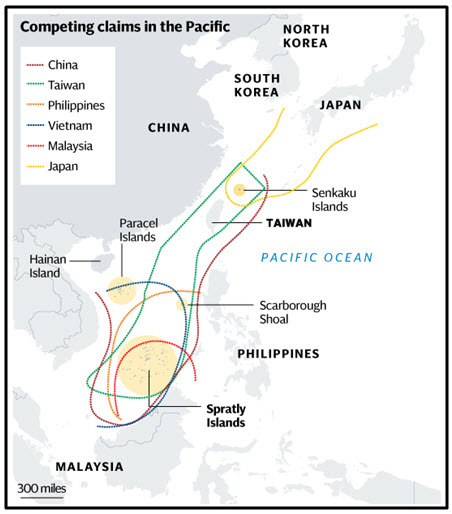 And yes, over the past year, Beijing has been very aggressive seeking to stake out its territorial claims and reach.
And yes, over the past year, Beijing has been very aggressive seeking to stake out its territorial claims and reach.
So much so that now, there’s the very real threat of a conflict between the U.S. and China.
Just consider the latest fighting words from U.S. Defense Secretary Ashton Carter, demanding a halt to land reclamation in disputed waters and vowing that the U.S. “will remain Asia’s leading power for decades to come.”
And that “There should be no mistake about this: The United States will fly, sail and operate wherever international law allows, as we do all around the world.”
China’s response, via the Global Times, a newspaper run by the Communist Party:
“If the United States’ bottom line is that China has to halt its activities, then a US-China war is inevitable in the South China Sea.”
Will there be a war between the U.S. and China?
It’s impossible to say at this time. But I do know this:
A. China will not back down on its efforts to claim what it believes is its sovereign claims to the South China Sea and the Spratly Islands. It needs the area’s vast natural resources and shipping lanes.
B. Washington will not back down either. Unfortunately, the powers-that-be in Washington still think they can be the lead influence in the rest of the world and have consistently failed to recognize that the geopolitical sands of time are changing.
C. Leaders in both countries would like nothing more than to distract their people’s attention from growing domestic problems. In the U.S. — a sluggish economy and a widening gap between the rich and the poor. In China — an extremely nationalistic population that views the South China Sea, like Hong Kong or Taiwan, as part of China … and a population that increasingly sees the U.S. as a threat to its economic rise.
Hopefully, it won’t come to war in the South China Sea. But given how the war cycles are slated to ramp higher for the next five to seven years, I wouldn’t be surprised if some sort of military conflict erupts between Washington and Beijing in the South China Sea or elsewhere.
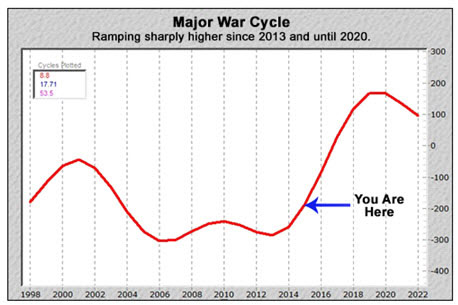 However, nearly all of these conflicts — even a future Sino-American war — are
However, nearly all of these conflicts — even a future Sino-American war — are
merely a manifestation of the deeper, pervasive impact of the big war cycle that’s ramping up and should continue to do so for the rest of the decade.
This is the same war cycle I’ve told you about repeatedly. And it’s the same one I’m displaying here again. —->
We see it everywhere. Rising domestic violence. Spreading international conflict. An unmistakable shift toward more separatism, anarchism and terrorism. Currency wars. Trade wars. Cyberespionage. Capital controls. And more.
What’s behind it? Much of the cycle is in parallel to a coming sovereign debt crisis — a crisis the likes of which hasn’t been seen in developed economies since the 1930s. It’s a crisis that …
Takes Europe into bankruptcy …
Leaves Japan unable to fund its massive liabilities, and …
Exposes the $235 trillion of patently unpayable debts of the United States of America for what they really are — the handiwork of emperors with no clothes.
That’s why these are dangerous times, far more dangerous than most realize.
And that’s why the investment implications are equally fraught with dangers — and opportunities, provided you have a good sense of history, a knowledge of how markets truly work, and you position yourself accordingly.
Start taking some big steps right now:
First, don’t let anyone convince you that all these global conflicts are somehow going to “die down” or “peter out.”
Second, remember that it’s never too early to prepare for the worst.
Third, if you own any sovereign bonds of the U.S., Europe or Japan — get the heck out and don’t look back.
Above all, stay safe!
Larry
The post War Cycles Spread Globally: Now China vs. US? appeared first on Money and Markets – Financial Advice | Financial Investment Newsletter.

 “This year marks the 57th year that I’ve been writing about the markets. During all these years a lot has changed, and I have changed too. Rather than write about every little jiggle in the markets, I now prefer to stick to the big picture.
“This year marks the 57th year that I’ve been writing about the markets. During all these years a lot has changed, and I have changed too. Rather than write about every little jiggle in the markets, I now prefer to stick to the big picture.
The Big Picture
The big picture, minus manipulations, propaganda and lies, is that the US is on the long road to deleveraging and deflation, which, of course, is a correction of the years since World War II, when the trend was towards inflation and leveraging. With the advent of the internet and email, this business has become increasingly difficult and not only have many newsletters dropped out of the field, but many hedge funds and money managers have thrown in the towel.
John Williams Exposes The Truth Behind The Lies
I’ve been reading John Williams’ newsletter on the economy. John calls his newsletter Shadow Statistics, and by that he
means that he’s telling the true story about the American economy minus government propaganda and Fed lies.
I’ve been wondering what to make of the major averages and indexes, whipping up and down within their trading ranges. Now it occurs to me that investors’ reaction to this oscillation is, “So what?” The stock market is going nowhere in a hurry. Thus investors have been lulled to sleep by the seemingly trendless activity of the major averages. Based on recent action in the stock market, I think the market could correct by 10% or more before investors will take it seriously.
My intuition tells me that John Williams and his Shadow Statistics are telling us the real story. I also suspect that the Fed agrees with the negative scenario that John Williams has presented. Therefore I assume that the Fed will not raise rates in the June session nor will it raise rates in September. After that comes an election year, during which the Fed will surely not raise rates. So it could easily be 2017 before we see the first rate rise by the Fed.
U.S. Debt Headed To $20 Trillion
In the meantime I expect the national debt to compound and accelerate, moving the national debt into the 18 to 20 trillion dollar zone. This will have its impact on the US dollar, which is now overbought and overloved. If the dollar crashes, the US will almost surely lose its reserve status. At that point I believe the Chinese yuan will share reserve status with the US dollar.
Gold Tracks The Direction Of Power
Throughout history, the path of gold has traced out the direction of power. But despite all this, I am an optimist. I believe we’ve reached the time when war between major powers has ended. Unbeknownst to most, spirituality and love are beginning to creep like a huge blanket over mankind.”
Time
Here’s something they won’t tell you at your local brokerage office or in the “How to Beat the Market” books.All investing and speculation is basically an exercise in attempting to beat time.
“Russell, what are you talking about?”
Just what I said — when you try to pick the winning stock or when you try to sell out near the top of a bull market or when you try in-and-out trading, you may not realize it but what you’re doing is trying to beat time.
Time is the single most valuable asset you can ever have in your investment arsenal. The problem is that none of us has enough of it.
But let’s indulge in a bit of fantasy. Let’s say you have 200 years to live, 200 years in which to invest. Here’s what you could do. You could buy $20,000 worth of municipal bonds yielding say 5.5%.
At 5.5% money doubles in 13 years. So here’s your plan — each time your money doubles you add another $10.000. So at the end of 13 years you have $40,000 plus the $10,000 you’ve added, meaning that at the end of 13 years you’d have $50,000.
At the end of the next 13 years you have $100,000, you add $10,000 and then you’d have $110,000. You reinvest it all in 5.5% munis and at the end of the next 13 years you’d have $220,000 and you add $10,000 making it $230,000.
At the end of the next 13 years you’d have $460,000 and you add $10,000 making it $470,000.
In 200 years there are 15.3 doubles. You do the math. By the end of the 200th year you wouldn’t know what to do with all your money. It would be coming out of your ears. And all with minimum risk.
So with enough time, you would be rich –guaranteed.You wouldn’t have to waste any time picking the right stock or the right group or the right mutual fund. You would just compound your way to riches, using your greatest asset — time.
There’s only one problem, In the real world you’re not going to live 200 years. But if you start young enough or if you start your kids early, you or they might have anywhere from 30 to 60 years of time ahead of you.
Because most people have run out of time, they spend endless hours and nervous energy trying to beat time, which, by the way, is really what investing is all about. Pick a stock that advances from 3 to 100 and if you’ve put enough money in that stock you’ll have beaten time. Or join a company that gives you a million options and your option moves up from 3 to 25 and again you’ve beaten time.
How about this real example of beating time– John Walter joined AT&T, but after nine short months he was out of a job. The complaint was that Walter “lacked intellectual leadership.”Walter got $26 million for that little stint in a severance package. That’s what you call really beating time. Of course, a few of us might have another word for it– and for AT&T.
You can subscribe to Richard Russell’s 90 years of wisdom and remarkable writings at Dow Theory Letters by CLICKING HERE TO SUBSCRIBE.

….The Global Money Tsunami is Back!
Two major bloody wars — in Syria and Iraq — are gaining momentum, reaching a tipping point, speeding toward a fatal climax.
A third, even larger war between the region’s oil superpowers — Iran and Saudi Arabia — is looming.
These wars are now spilling over into Africa, Asia and Europe.
They are forcing millions of people to flee for their lives.
And they are driving billions of dollars to rush to safety.
This is not just my opinion.
It’s also the very somber-and-sober assessment of serious analysts at respected Washington think tanks, in the Pentagon and in the region itself.
It’s precisely what Larry Edelson has been forecasting, consistently and unambiguously, since his now-famous War Cycles speech on a 2013 Weiss Research investment cruise.
 And it’s happening — right now, all over the world:
And it’s happening — right now, all over the world:
Most of the war refugees are fleeing to Europe, by sea, by land, by air, legally and illegally. But just as we warned, most of the flight capital is flowing to the world’s largest, militarily strongest, most liquid, safe haven — the United States.
We call it …
The Global Money Tsunami
It’s gushing into choice U.S. real estate, helping to drive up the value of American homes, commercial properties, industrial real estate and more.
It’s rushing into U.S. stocks, one of the key factors driving the Dow, the S&P 500, and the Nasdaq Composite to new all-time highs.
And no matter where these global investors put their money, the last thing they want is to jump from one danger to another.
They want stability, liquidity and a good measure of safety — choice locations for real estate and extreme high quality for stocks.
Of course, you and I are aware of the investment risks in the United States. But for many foreign investors, what we
might consider to be a threat here at home is little more than a tickle on their toes. Just take a closer look at what they’re seeing in their home countries or regions, and you’ll see what I mean …
The Mad, Bloody Rampage of Islamic State (ISIS or ISIL)
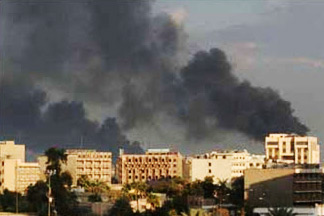 Three key cities have gone down …
Three key cities have gone down …
Mosul, Iraq’s second largest city, 250 miles from Baghdad, with twice the population of San Francisco, fell to the Islamic State one year ago.
On the night of June 9, 2014, an estimated 1,300 armed militants seized government offices, army facilities, and the Mosul International airport. They beheaded hundreds of government supporters. They drove a half-million residents to flee the city. And they sent tens of thousands of government troops into a panicky retreat.
All by using the power of sheer terror and unthinkable brutality!
From there, they fanned out over Iraq’s Anbar province, larger than the state of North Carolina or New York. And despite massive U.S. coalition bombing, they’re doing it again and again …
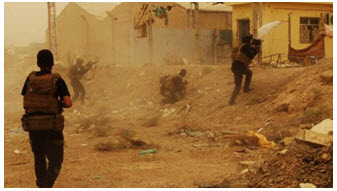 Ramadi, the Anbar provincial capital just 68 miles from Baghdad, fell to the Islamic State just 15 days ago.
Ramadi, the Anbar provincial capital just 68 miles from Baghdad, fell to the Islamic State just 15 days ago.
The militants loaded a series of armored bulldozers and trucks with massive amounts of explosives, manned them with suicide bombers and used them like mini-nukes to utterly obliterate government complexes.
They rounded up the wives and children of government officials, killed them on the spot and sent the rest of the government into a wild retreat out of the city, escorted by tanks. The Iraqi army, including U.S.-trained special forces, soon followed.
 Palmyra, a strategic city and UNESCO World Heritage Site in Syria, fell to the Islamic State three days later.
Palmyra, a strategic city and UNESCO World Heritage Site in Syria, fell to the Islamic State three days later.
At first, it was reported that Syrian army forces evacuated the city’s civilians to save them from an inevitable massacre. But residents reported that high-ranking army officers were the first to flee the city, leaving all others to fend for themselves. Mass executions soon followed.
The very next day, Islamic State proceeded to capture the last government-held border crossing with Iraq plus strategic military bases, while another extremist group announced that the fall of Damascus, the capital of Syria, was next.
And as The New York Times recently demonstrated, this is just a microcosm of the rapid, mass expansion of Islamic State across the Middle East, Africa and Asia. Islamic State now directly controls and governs vast areas and large population centers of Syria and Iraq.
Their empire or terror stretches all the way from towns near the Syrian capital Damascus in the West to the outskirts of Baghdad 500 miles to the East.
That’s like controlling the states and cities between the outskirts of Chicago to the suburbs of New York City.
But it’s just one way Islamic State is expanding. Their second tactic is infiltration.
As the Times explains it, “The Islamic State infiltrates local groups, often using intimidation to influence community leaders. They also establish sleeper cells that emerge at critical moments. The invasion of Ramadi relied on local sleeper cells. ISIS cells surfaced in Arsal, Lebanon, when local rebel groups rose up against the government.
“Analysts believe that the Islamic State is building networks in Saudi Arabia and in the Kabylie region of Algeria in order to seed uprisings. In Yemen, an Islamic State cell added fuel to the escalating crisis there by carrying out bombings that killed 135 people in two mosques in March. The country is now in chaos.”
Most alarming of all is their third tactic: Absorbing other extremists groups.
At least 30 jihadist groups across 18 nations have already pledged support or allegiance to the Islamic State.
In Libya, for example, extremists in all three of the country’s regions have aligned with the Islamic State, transforming much of the country into their own, private training grounds.
As you can see from the New York Times’s global map above, we’re now talking about a vast area of Islamic State influence that stretches from the Atlantic to the Pacific.
That includes billions of people with trillions of dollars in wealth — many directly or indirectly threatened by Islamic State, many more feeling increasingly frightened by those threats, whether real or not.
Now do you see why so much flight capital is rushing to the world’s safest haven? Well, that’s just the beginning of the story …
Looming War Between Two Oil Superpowers
The world’s largest oil superpower (Saudi Arabia with 268 billion barrels in proven oil reserves) is now on a warpath with the world’s second largest oil superpower (Iran, with 157 billion).
Hard to believe? Then consider the facts:
In just the five months since he was crowned in January, the new Saudi King Salman has already taken a series of tactical steps to prepare for war:
He has built a formidable alliance of Sunni Muslim nations to counter Shiite forces in the region.
He has thoroughly shaken up the Saudi royal line of succession, installing strong military leaders to key positions to succeed him.
He has greatly expanded the nation’s procurement of U.S. weaponry.
And by attacking neighboring Yemen, he has launched Saudi Arabia’s first war against Shiite forces in modern history.
Moreover, the forces driving the two countries into a conflict are among the most powerful of history:
First, religion — the Sunni-Shiite rift — pits their governments, their militaries and nearly their entire populations on opposite warring sides.
This is the conflict that dates back to 7th century brutal wars over the succession of the Prophet Mohammed. And it’s a conflict that’s been reignited in modern times by events that are now spinning out of control — the rise to power of the Shiite clerics in Iran … the U.S.-inspired Shiite takeover of the government in Iraq … and now, the possible fall of Baghdad.
Second, geopolitical influence — the all-out, all-consuming, oft-fanatic drive by each to be the dominant power of control and influence in the entire region.
The Iranians claim to be the rightful regional leader thanks to their large population, big military, strong anti-Israel rhetoric, and, yes, their nuclear program. Meanwhile …
The Saudis make the same claim, based on their huge oil reserves, their holiest of Muslim cities (Mecca and Medina), their huge financing of major nations like Egypt, and most recently, their war on Shiite rebels in Yemen.
Third, both countries accuse each other of abusing their brethren — the Shiite minority in Sunni Saudi Arabia and the Sunni minority in Shiite Iran. This may not be a real reason to go to war. But each country’s propaganda machine uses any abuses or atrocities of religious minorities to fire up hatred and heat up the winds of war.
What about the potential consequences of a Saudi-Iranian conflict? They’re enormous …
1. Despite the recent oil-price decline, over the years, oil profits have led to one of the greatest accumulations of wealth in the history of mankind — much of it in liquid assets held locally or in major financial capitals. This vast pool of money is contributing a big part of the Global Money Tsunami now reaching our shores.
2. Despite any temporary glut, a Saudi-Iranian conflict would immediately threaten the world’s oil supplies. You probably remember talk from years ago — about the narrow Strait of Hormuz through which most oil must flow from the Persian Gulf to the world. That was during the first Gulf War. But the dangers then pale by comparison to the dangers now.
On one side of the Strait of Hormuz is the Saudi Peninsula. On the other is Iran.
It remains the world’s most important oil passageway, with oil flows representing a whopping one-third of all the oil in the world that’s transported by sea. Even just the threat of conflict is hugely disruptive. And any actual harassment or infrastructural damage — let alone outright closure — will send shock waves through oil markets.
3. Worst of all, a Saudi-Iranian conflict would force the world’s superpowers and wannabe superpowers to take sides — the U.S. and E.U. on the Saudi side, Russia and China on the Shiite side. With a cold war between them already heating up, the economic consequences are both unthinkable and unpredictable.
So if you think a war between Saudi Arabia and Iran is unlikely, unimportant or just plain crazy, think again. It’s not.
In fact, just the fear of this conflict, now widespread in the region, is already driving hundreds of billions of dollars into the Global Money Tsunami.
Russian Money Flowing to the U.S. in Huge Amounts
Just when some analysts believe Russia’s incursions into the Ukrainian conflict are over, they discover exactly the opposite.
Just when most Americans begin to forget about Russia’s president Vladimir Putin, he raises his head again with another major verbal attack on the West.
And just when they think Russia’s millionaires and billionaires are mostly done pouring their money into the U.S., new torrents of rubles arrive.
In the second half of 2014, for example, the capital flows out of Russia were over ten times larger than those of the year-earlier period. And in 2015, the outflows have accelerated even further — most of them seeking to buy up choice stocks and real estate in the United States.
Larry will give you a complete update on these critical money flows — and what to do about them — Wednesday. In the meantime, be sure to stay on the alert for these kinds of black swan events.
Good luck and God bless!
Martin
….more from Marting on Money and Markets – Financial Advice | Financial Investment Newsletter.

 Many in Spain are starting to figure out that the only way to survive is to get your money out of the bank. Accounts can just be frozen as they did to the Russians living in Spain demanding they prove the source of their funds. Banco Madrid has had its funds frozen while the government tries to figure out if it will rescue the bank or not. Meanwhile, people who saved their money cannot get access to it. People are starting to wise up here and are looking at getting their money out of banks and into alternatives including real estate, stocks, and out of the country.
Many in Spain are starting to figure out that the only way to survive is to get your money out of the bank. Accounts can just be frozen as they did to the Russians living in Spain demanding they prove the source of their funds. Banco Madrid has had its funds frozen while the government tries to figure out if it will rescue the bank or not. Meanwhile, people who saved their money cannot get access to it. People are starting to wise up here and are looking at getting their money out of banks and into alternatives including real estate, stocks, and out of the country.
Because Europe has routinely cancelled currencies in the past, they will use that option if they suddenly decide to move to electronic perhaps in October. I highly recommend that cash you may hoard should not be Euros – use US dollars. The US has never cancelled its currency and it may be much harder for the USA to just cancel the currency overnight given the huge amount of dollars that circulate around the world.
So try to look at alternatives here. If you use US shares, you may want to take possession of the share certificates. The blue chips will be the most liquid, but naturally other aspects of the market may start to outperform the blue chips. Use dollars to hoard and gold coins. You just cannot leave them in a bank safe deposit box.
…more from Martin:
(for math wizards) The Schema Frequency












